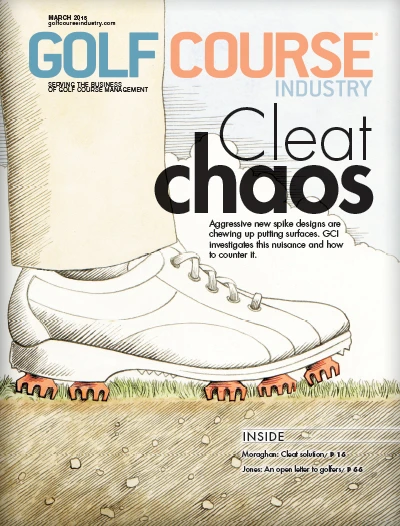
 Tim Moraghan Tim Moraghan |
The issue of golf shoes and cleats damaging the golf course – specifically greens – is gaining traction. After raising concerns last month in this column, I’ve heard from superintendents and others in the industry. Their reaction added fuel to the fire, which is why GCI devoted this month’s cover story to the problem. All of which is well and good. We need to identify and acknowledge the problem before we can do anything about it. But what can we do about it? Much more than you think. And it starts with us. SuperintendentsIt starts locally. Review our own course, which means doing a careful, hole-by-hole, green-by-green analysis of what sort of damage is being done, where it’s worst, and where it’s limited. Are you hearing complaints from your members about course conditions? How much can be attributed to shoes/cleats? Can you identify particular shoes/cleats that are doing the most damage? Be careful that you’re not using shoes/cleats as an excuse to explain other agronomic problems. Are you doing enough to promote healthy turfgrass in the most susceptible areas? Be sure to differentiate between damage to greens and damage to other parts of the course where its impact isn’t as great or unexpected. Review your height-of-cut policy since green surfaces seem to suffer more damage when closely mown. Your greens probably would be healthier and more resistant to scuffing and scraping if the grass were a little longer. And I’ll bet most of your golfers won’t even notice. As for the “good players” who want faster greens, I’ll bet they’re among the worst offenders when it comes to damaging the greens. Perhaps most important, is shoe damage affecting your maintenance budget? Are you sending crews out to fix this damage when they should be doing something else? Are spending more on seed, fertilizer, or labor? Because this is the information that will be of most interest when you take it up the line to… Green/Golf Committees and Club ManagementAs soon as there’s evidence of damage, get your committees involved. Not only do they need to know (to approve extra money, if necessary, and take other action), but you can’t be the lone voice on this. It’s too big, affects too many people and courses, and can easily blow up in your face (and your job) if you don’t have the support and understanding of club management. Tell the committees everything you’ve learned: most susceptible areas of the course (do you need to mark more “ground under repair” areas?); most damaging shoes/cleats (should the club ban certain makes and models?); possible responses to the problem (are they okay with higher cuts?). You are the expert and the committees should listen to you, but only if you come to them with facts, figures and some remedies. Where you really need the committees’ support is dealing with the other golfers/members. You’ll be the point person, of course, but it’s the committeemen and club officers who have to convince their fellow members that evaluating every brand of shoe and cleat is in the best interest of the course, and to take whatever actions you collectively deem necessary. The committee members need to approach the worst offenders to affect change. Taking this responsibility on by yourself is not a good idea. You also need the support of… The Golf ProIf you have a good relationship with your pro, now’s the time to make the most of it. Especially if his favorite brand of shoe – and the one he’s selling most of – is a leading offender. Chances are the pro has noticed the same damage you have as he’s hearing complaints from members, especially when they’re out playing and scratched, torn turf is affecting their money putts. If your pro puts up a fight, remind him/her of this: Shop revenue depends on the number of players on the course; if course conditions decline, so will the number of players. Even if you aren’t best buddies, on this issue you should be soul mates. Check out which shoes are for sale in the shop. Ask the pro which are the best sellers and determine if they’re among the worst offenders. Maybe he can stock some other models or more choices in replacement cleats that are less intrusive. Even if he does stop selling certain shoes, that won’t stop Mr. Smith from going to the big-box golf store and buying them. But the pro’s word usually has more sway with the members than yours does, so get him on your side. If this is a serious enough problem – and especially if you’re hearing the same complaints from other supers and pros in your region – ask your pro to take it up with his local association and begin pushing it up the ladder of influence, the next step of which is… Local AssociationsRaise the issue of shoe/cleat damage at your local superintendent chapter meetings. Encourage other supers to do the same sort of research you did to identify where and how damage is occurring. From the local chapters, move up to state and regional groups. I guarantee you’ll find other superintendents and pros dealing with these same problems at every level. You won’t know until you start to ask and make noise. They’re probably as nervous as you are about ruffling feathers, but it only takes a few people with like minds and similar concerns to begin affecting change. There are a few specific questions to ask at all levels, including: What’s been the impact on labor costs? Are you having to use more/different chemicals and fertilizers? Do you have to change your maintenance practices? Are your members/players complaining, and therefore do you feel your job is in danger? Once there’s a small group of you who’ve identified the problems and are in need of solutions, ask your local, state, and regional chapters to allocate funds to do more comprehensive, professional research. Because now you need to collect and analyze the data. And to do that right, contact… Research facilities/universitiesGet your regional groups involved as soon as possible asking schools and research labs to conduct studies and tests that accurately measure the breadth and depth of the problem. The leading universities that study turf and other golf-related issues would be thrilled to get involved with shoe/cleat research if they see enough local evidence of problems. Once those schools are involved, it’s time to talk to… The Big BoysAt some point, this issue is going to land squarely at the feet of the shoe manufacturers and golf’s governing bodies, notably the USGA, PGA of America, and our own GCSAA. If these organizations are truly committed to preserving and protecting the game (both for their members and the golfing public), they’re going to have to conduct their own research and – just as they’ve done with long putters, the environment and other issues – take a stand. It will take time, but it will happen. But only if… It Starts With YouEach one of you, individually, at your own course. Then talking to others in your area. Then taking it up the ladder step by step. This issue can get the attention it deserves at every level, but only if you take it upon yourself to do your part.
Tim Moraghan, principal, ASPIRE Golf (tmoraghan@aspire-golf.com). Follow Tim’s blog, Golf Course Confidential at http://www.aspire-golf.com/buzz.html or on Twitter @TimMoraghan |
Get curated news on YOUR industry.
Enter your email to receive our newsletters.
Explore the March 2015 Issue
Check out more from this issue and find your next story to read.
Latest from Golf Course Industry
- Turfco introduces riding applicator
- From the publisher’s pen: The golf guilt trip
- Architect Brian Curley breaks ground on new First Tee venue
- Turfco unveils new fairway topdresser and material handler
- Ignite Attachments adds new box plane and grapple
- Mackenzie & Ebert working on new Caribbean course
- Keswick Hall renovating Full Cry course ahead of big year
- The alpha wolf







